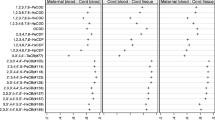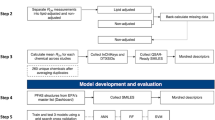Abstract
The present study aims to predict the maternal–fetal transfer rates of the polychlorinated biphenyls (PCBs), organochlorine pesticides (OCPs), and polybrominated diphenyl ethers (PBDEs), and dioxin-like compounds using a quantitative structure–activity relationship model. The relation between the maternal–fetal transfer rate and the contaminants’ physicochemical properties was investigated by multiple linear regression (MLR), partial least square regression (PLS), and random forest regression (RF). The 10-fold cross-validation technique estimated low predictive performances for both MLR and PLS models (R 2 CV = 0.425 ± 0.0964 for MLR and R 2 CV = 0.492 ± 0.115 for PLS) and is in agreement with an external test (R 2 pred = 0.129 for MLR and R 2 pred = 0.123 for PLS). In contrast, the RF model exhibits good predictive performance, estimated through 10-fold cross-validation (R 2 CV = 0.566 ± 0.0885) and an external test set (R 2 pred = 0.519). Molecular weight and polarity were selected in all models as important parameters that may predict the ability of a molecule to cross the placenta to the fetus.

Similar content being viewed by others
References
Akaike H (1998) Information theory and an extension of the maximum likelihood principle. In: Parzen E, Tanabe K, Kitagawa G (eds) Selected papers of Hirotugu Akaike. Springer, New York
Ankley GT, Bennett RS, Erickson RJ, Hoff DJ, Hornung MW, Johnson RD, Mount DR, Nichols JW, Russom CL, Schmieder PK, Serrrano JA, Tietge JE, Villeneuve DL (2010) Adverse outcome pathways: a conceptual framework to support ecotoxicology research and risk assessment. Environ Toxicol Chem 29:730–741
Audus KL (1999) Controlling drug delivery across the placenta. Eur J Pharm Sci 8:161–165
Aylward LL, Hays SM, Kirman CR, Marchitti SA, Kenneke JF, English C, Mattison DR, Becker RA (2014) Relationships of chemical concentrations in maternal and cord blood: a review of available data. J Toxicol Environ Health Part B 17:175–203
Bourget P, Roulot C, Fernandez H (1995) Models for placental-transfer studies of drugs. Clin Pharmacokinet 28:161–180
Breiman L (2001) Random forests. Mach Learn 45:5–32
Brouwer A, Ahlborg UG, Vandenberg M, Birnbaum LS, Boersma ER, Bosveld B, Denison MS, Gray LE, Hagmar L, Holene E, Huisman M, Jacobson SW, Jacobson JL, Koopmanesseboom C, Koppe JG, Kulig BM, Morse DC, Muckle G, Peterson RE, Sauer PJJ, Seegal RF, Smitsvanprooije AE, Touwen BCL, Weisglaskuperus N, Winneke G (1995) Functional aspects of developmental toxicity of polyhalogenated aromatic hydrocarbons in experimental animals and human infants. Eur J Pharmacol-Environ 293:1–40
Deeley RG, Westlake C, Cole SPC (2006) Transmembrane transport of endo- and xenobiotics by mammalian ATP-binding cassette multidrug resistance proteins. Physiol Rev 86:849–899
EPA (2012) U. Estimation Programs Interface Suite™ for Microsoft® Windows, v 4.11. United States Environmental Protection Agency, Washington, DC, USA
Fukata H, Omori M, Osada H, Todaka E, Mori C (2005) Necessity to measure PCBs and organochlorine pesticide concentrations in human umbilical cords for fetal exposure assessment. Environ Health Perspect 113:297–303
Giaginis C, Zira A, Theocharis S, Tsantili-Kakoulidou A (2009) Application of quantitative structure-activity relationships for modeling drug and chemical transport across the human placenta barrier: a multivariate data analysis approach. J Appl Toxicol 29:724–733
Grandjean P, Landrigan PJ (2006) Developmental neurotoxicity of industrial chemicals. Lancet 368:2167–2178
Grandjean P, Landrigan PJ (2014) Neurobehavioural effects of developmental toxicity. Lancet Neurol 13:330–338
Hewitt M, Madden JC, Rowe PH, Cronin MTD (2007) Structure-based modelling in reproductive toxicology: (Q)SARs for the placental barrier. SAR QSAR Environ Res 18:57–76
Jiang YZ, Wang K, Fang R, Zheng J (2010) Expression of aryl hydrocarbon receptor in human placentas and fetal tissues. J Histochem Cytochem 58:679–685
Jotaki T, Fukata H, Mori C (2011) Confirmation of polychlorinated biphenyl (PCB) distribution in the blood and verification of simple quantitative method for PCBs based on specific congeners. Chemosphere 82:107–113
Kawashiro Y, Fukata H, Inoue MO, Kubonoya K, Jotaki T, Takigami H, Sakai SI, Mori C (2008) Perinatal exposure to brominated flame retardants and polychlorinated biphenyls in japan. Endocr J 55:1071–1084
Koppe JG, Olie K, Vanwijnen J (1992) Placental transport of dioxins from mother to fetus. 2. PCBS, dioxins and furans and vitamin-K metabolism. Dev Pharmacol Ther 18:9–13
Kovdienko NA, Polishchuk PG, Muratov EN, Artemenko AG, Kuz'min VE, Gorb L, Hill F, Leszczynski J (2010) Application of random forest and multiple linear regression techniques to QSPR prediction of an aqueous solubility for military compounds. Mol Inf 29:394–406
Kuhn M (2008) Building predictive models in R using the caret package. J Stat Softw 28:1–26
Lancz K, Murínová Ľ, Patayová H, Drobná B, Wimmerová S, Šovčíková E, Kováč J, Farkašová D, Hertz-Picciotto I, Jusko TA, Trnovec T (2015) Ratio of cord to maternal serum PCB concentrations in relation to their congener-specific physicochemical properties. Int J Hyg Environ Health 218:91–98
Lewis DFV, Modi S, Dickins M (2002) Structure-activity relationship for human cytochrome P450 substrates and inhibitors. Drug Metab Rev 34:69–82
Mably TA, Bjerke DL, Moore RW, Gendron-Fitzpatrick A, Peterson RE (1992) In utero and lactational exposure of male rats to 2,3,7,8-tetrachlorodibenzo-p-dioxin: 3 effects on spermatogenesis and reproductive capability. Toxicol Appl Pharmacol 114:118–126
Manchester DK, Gordon SK, Golas CL, Roberts EA, Okey AB (1987) Ah receptor in human placenta—stabilization by molybdate and characterization of binding of 2,3,7,8-tetrachlorodibenzo-para-dioxin, 3-methylcholanthrene, and benzo(a)pyrene. Cancer Res 47:4861–4868
Marchesini GR, Meimaridou A, Haasnoot W, Meulenberg E, Albertus F, Mizuguchi M, Takeuchi M, Irth H, Murk AJ (2008) Biosensor discovery of thyroxine transport disrupting chemicals. Toxicol Appl Pharmacol 232:150–160
Meylan WM, Howard PH (2000) Estimating log P with atom/fragments and water solubility with log P. Perspect Drug Discov 19:67–84
Monteiro CJP, Pereira MM, Pinto SMA, Simoes AVC, Sa GFF, Arnaut LG, Formosinho SJ, Simoes S, Wyatt MF (2008) Synthesis of amphiphilic sulfonamide halogenated porphyrins: MALDI-TOFMS characterization and evaluation of 1-octanol/water partition coefficients. Tetrahedron 64:5132–5138
Mori C, Nakamura N, Todaka E, Fujisaki T, Matsuno Y, Nakaoka H, Hanazato M (2014) Correlation between human maternal-fetal placental transfer and molecular weight of PCB and dioxin congeners/isomers. Chemosphere 114:262–267
Myllynen P, Pasanen M, Pelkonen O (2005) Human placenta: a human organ for developmental toxicology research and biomonitoring. Placenta 26:361–371
Myllynen P, Immonen E, Kummu M, Vahakangas K (2009) Developmental expression of drug metabolizing enzymes and transporter proteins in human placenta and fetal tissues. Expert Opin Drug Metab 5:1483–1499
Needham LL, Grandjean P, Heinzow B, Jorgensen PJ, Nielsen F, Patterson DG, Sjodin A, Turner WE, Weihe P (2011) Partition of environmental chemicals between maternal and fetal blood and tissues. Environ Sci Technol 45:1121–1126
Pasanen M (1999) The expression and regulation of drug metabolism in human placenta. Adv Drug Deliv Rev 38:81–97
Qi Y (2012) Random forest for bioinformatics. In: Zhang C, Ma Y (eds) Ensemble machine learning. Springer, US
Reynolds F (1998) Drug transfer across the term placenta: a review. Placenta 19(Supplement 2):239–255
Rucker C, Rucker G, Meringer M (2007) y-Randomization and its variants in QSPR/QSAR. J Chem Inf Model 47:2345–2357
Sakurai K, Todaka E, Saito Y, Mori C (2004) Pilot study to reduce dioxins in the human body. Intern Med 43:792–795
Stewart JJP (2007) Optimization of parameters for semiempirical methods V: modification of NDDO approximations and application to 70 elements. J Mol Model 13:1173–1213
Stewart JJP, MOPAC 2009 Version 9.03CS. Stewart Computational Chemistry. HTTP://OpenMOPAC.net: 2008
Tropsha A (2010) Best practices for QSAR model development, validation, and exploitation. Mol Inf 29:476–488
Ucan-Marin F, Arukwe A, Mortensen AS, Gabrielsen GW, Letcher RJ (2010) Recombinant albumin and transthyretin transport proteins from two gull species and human: chlorinated and brominated contaminant binding and thyroid hormones. Environ Sci Technol 44:497–504
Vahakangas K, Myllynen P (2009) Drug transporters in the human blood-placental barrier. Br J Pharmacol 158:665–678
Van den Berg M, Birnbaum LS, Denison M, De Vito M, Farland W, Feeley M, Fiedler H, Hakansson H, Hanberg A, Haws L, Rose M, Safe S, Schrenk D, Tohyama C, Tritscher A, Tuomisto J, Tysklind M, Walker N, Peterson RE (2006) The 2005 World Health Organization reevaluation of human and mammalian toxic equivalency factors for dioxins and dioxin-like compounds. Toxicol Sci 93:223–241
Wold S, Sjostrom M, Eriksson L (2001) PLS-regression: a basic tool of chemometrics. Chemom Intell Lab 58:109–130
Zhang SX, Golbraikh A, Oloff S, Kohn H, Tropsha A (2006) A novel automated lazy learning QSAR (ALL-QSAR) approach: method development, applications, and virtual screening of chemical databases using validated ALL-QSAR models. J Chem Inf Model 46:1984–1995
Acknowledgments
These studies were supported by grants for Scientific Research (A): Grants-in-Aid for Scientific Research <KAKENHI (20241016)>, Scientific Research (B): Grants-in-Aid for Scientific Research <KAKENHI (24310021)>, Grant-in-Aid for Research Activity start-up (26881003) from the Japanese Ministry of Education Culture, Sports, Science and Technology, and the Environment Research and Technology Development Fund (5-1305) from the Ministry of the Environment of Japan.
Author information
Authors and Affiliations
Corresponding author
Additional information
Responsible editor: Roland Kallenborn
Rights and permissions
About this article
Cite this article
Eguchi, A., Hanazato, M., Suzuki, N. et al. Maternal–fetal transfer rates of PCBs, OCPs, PBDEs, and dioxin-like compounds predicted through quantitative structure–activity relationship modeling. Environ Sci Pollut Res 25, 7212–7222 (2018). https://doi.org/10.1007/s11356-015-5436-0
Received:
Accepted:
Published:
Issue Date:
DOI: https://doi.org/10.1007/s11356-015-5436-0




